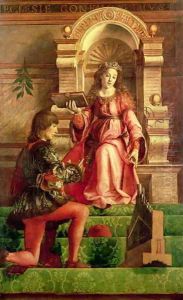Joos van Gent (Joos van Wassenhove) Paintings
Joos van Gent, also known as Joos van Wassenhove, was a Flemish painter active during the Renaissance period, whose exact birth and death dates are not precisely known but are generally estimated around 1410-1420 for his birth and around 1480 for his death. His work signifies a bridge between the early Netherlandish painting traditions and the Italian Renaissance, marking him as a pivotal figure in the history of Western art. Despite the scarcity of biographical details, it is believed that he was originally from either Ghent or Wassenhove, as indicated by his names.
Joos van Gent is perhaps best known for his role in the introduction of Italian Renaissance art styles to the Northern European regions. This was largely facilitated through his time in Urbino, Italy, where he was active from the 1460s. During his stay in Italy, he became a court painter for Federico da Montefeltro, Duke of Urbino, one of the most enlightened patrons of the arts in the Renaissance era. This position not only allowed Joos to absorb Italian artistic innovations firsthand but also to contribute significantly to the cultural exchange between Italy and the Low Countries.
His oeuvre includes religious subjects, portraits, and mythological scenes, characterized by their meticulous attention to detail, vibrant colors, and the incorporation of perspective, a relatively new concept in Northern European art of the time. One of his most celebrated works is the 'Communion of the Apostles,' executed for the Ducal Palace in Urbino. This painting, believed to be one of the first to depict the Last Supper in the context of Renaissance humanism, showcases his mastery of perspective and his ability to infuse traditional religious subjects with a new sense of depth and realism.
Despite his significant contributions, Joos van Gent remains a somewhat enigmatic figure, with few documented facts about his life. His influence, however, is evident in the works of later Flemish and Italian artists, underscoring his role in the spread of Renaissance ideas across Europe. His legacy is a testament to the vital interchange of ideas and techniques between the North and South of Europe during the Renaissance, making him a key figure in the history of art.
